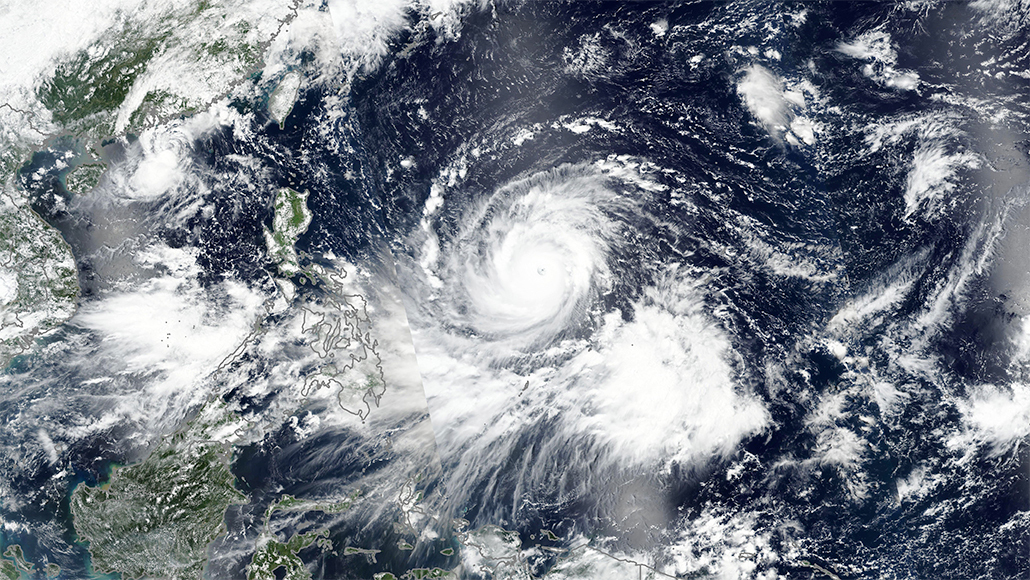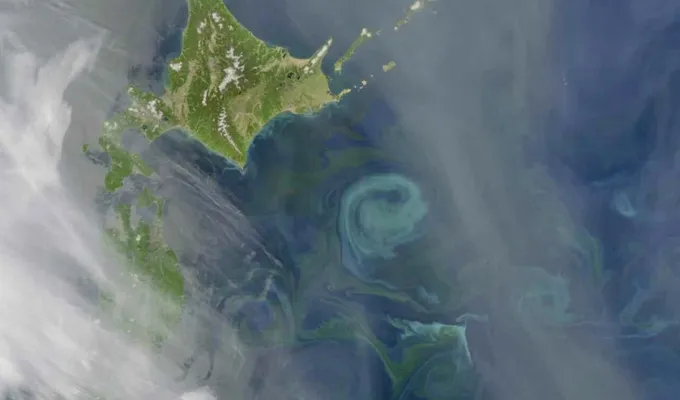
Super-typhoon Mangkhut (shown) swept past the Philippines on September 12, 2018, as a Category 5 storm. Collisions of such powerful tropical cyclones with spinning ocean whirlpools called eddies may be accelerating heat-carrying ocean currents like the Kuroshio.
Lauren Dauphine/NASA Earth Observatory (using VIIRS data from the Suomi National Polar-orbiting Partnership)
- More than 2 years ago
Increasingly powerful tropical cyclones in the North Pacific Ocean may be fueling a powerful north-flowing ocean current, helping to boost the amount of heat it ferries to northern latitudes. By enhancing the speed of some ocean whirlpools called eddies, and suppressing the spin of others, the passing storms may be accelerating the heat-carrying Kuroshio Current — and that could warm the planet further, researchers report in the May 29 Science.
Researchers have long predicted that climate change would increase the intensity of tropical cyclones around the planet. Some observational data, including a recent study of tropical cyclone intensity over the last four decades, suggest that this supercharging of storms is already happening.
Yet tropical cyclones’ own influence on the climate isn’t generally included in most climate simulations. The interaction of these relatively short-lived storms with a calm, quiescent ocean has been considered insignificant in the long-term climate picture, says Yu Zhang, a physical oceanographer at the Ocean University of China in Qingdao.
But, in reality, the ocean is anything but quiescent, she says: It is full of energetic eddies, large swirls of water that spin off of large, fast-moving currents (SN: 6/9/03). These swirls, known as mesoscale eddies, tend to persist for perhaps a few months, span 10 to 100 kilometers across and can extend more than 1,000 meters deep. That makes the ephemeral eddies key players in mixing up and redistributing the ocean’s heat, salt and nutrient content (SN: 9/27/08).
“The collision of these two giant monsters — tropical cyclones and mesoscale eddies — will probably lead to dramatic climatic impacts that are far beyond our imagination,” Zhang says.
A third powerful player in the North Pacific is the Kuroshio Current, a swift, broad ocean current that originates off the east coast of the Philippines and transports warm, tropical waters northward toward Japan, warming the climate, nourishing rich fishing grounds and allowing the world’s northernmost coral reefs to thrive. The Kuroshio is analogous to the North Atlantic’s Gulf Stream, which brings warm waters and a balmy climate to northwestern Europe (SN: 1/31/19).
The Kuroshio’s speed is primarily linked to winds. Puzzlingly, the push of those winds has decreased in strength by more than 30 percent, on average, in the last 20 years, but the Kuroshio has not slowed as much as would be expected, Zhang says.
She and her colleagues suspected that changes in the spin of ocean eddies in the region — linked to the intensification of North Pacific tropical cyclones — were helping to keep the Kuroshio speeding along. To investigate, the researchers used a combination of satellite data and ocean-based Argo floats, which track temperature and salinity. The team then examined how eddies’ energy and spinning motion, called “potential vorticity,” were changed when the swirls interacted with a passing tropical cyclone.
The storms, the team found, increased the strength of eddies spinning counterclockwise while decreasing the strength of eddies spinning in the opposite direction. When the eddies spin back into the current — as they might, for example, off the coast of Taiwan — the strengthened counterclockwise eddies, on balance, help accelerate the northward flow, the researchers say.

Speeding up the Kuroshio could create a positive feedback loop to global warming by delivering more heat to higher latitudes, helping to warm them even more, the researchers say. That warming then could drive stronger cyclones that could in turn speed up the current more in a continual cycle.
A similar scenario, in which more powerful tropical cyclones accelerate the Gulf Stream, is likely playing out in the North Atlantic Ocean, Zhang adds. However, researchers are less clear about what role climate change is playing in the intensification of North Atlantic Ocean hurricanes. In that region, another culprit that is supercharging the storms is a large, natural ocean-atmospheric climate pattern known as the Atlantic Multidecadal Oscillation.
The authors “make a compelling case for a feedback of tropical cyclones on global warming,” says Kerry Emanuel, an atmospheric scientist at MIT. By strengthening the Kuroshio, this mechanism could, in principle, “accelerate warming outside the tropics,” he says.
Takeyoshi Nagai, a physical oceanographer at Tokyo University of Marine Science and Technology, notes that the study focuses on how these eddies might be strengthening the Kuroshio in its more southerly portions. But as the current winds to the north, nearer to Japan, the pattern of ocean eddies becomes even more complex, and it’s less clear what impact storm-altered eddies might have on this part of the current, he says. Better understanding of that interplay would be especially useful, as that’s also the region where extra heat could most affect climate and the fishing industry, by shifting, for example, the mix of fish species.






